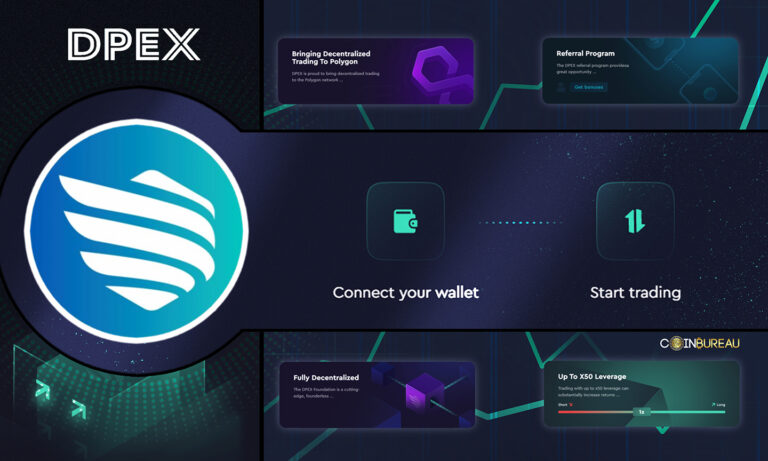The cryptocurrency space has changed a lot since Bitcoin was born. Today, there are over 7400 cryptocurrencies and counting. The original altcoins from the early days consequently find themselves in a crowded and competitive space. While most of these have not stood the test of time, one of the few that has is Litecoin, and it has managed to do so by standing in Bitcoin’s shadow.
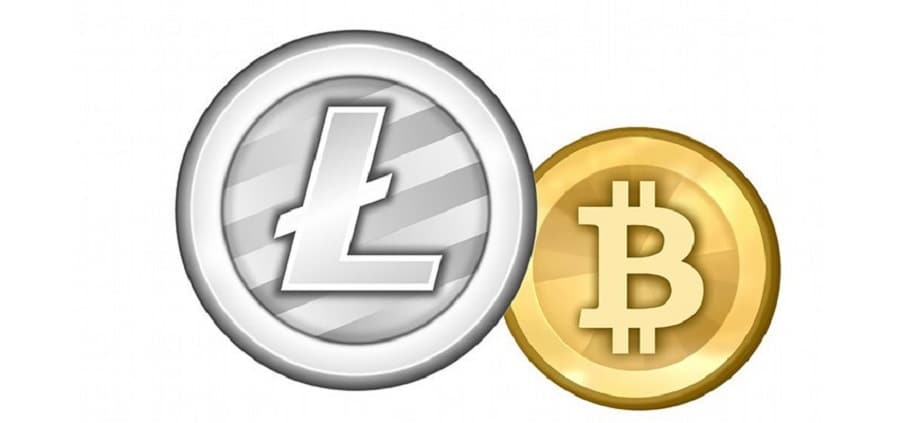
Image via Alza
Believe it or not, Litecoin is quite important for Bitcoin. It has served as the testbed for many features which were eventually added to Bitcoin. Segwit and the Lightning Network are just two examples. This fact alone warrants a close examination of this ‘digital silver’ cryptocurrency. It may give us some valuable insight into the future of Bitcoin and by extension the entire cryptocurrency market. Spoiler: privacy might be next.
Page Contents 👉
A brief history of Litecoin
Litecoin was created by Charlie Lee. Charlie has a master’s degree in computer science from MIT and worked as a software engineer for Google for almost 6 years. An avid poker player, he was one of thousands affected by the Black Friday crackdown on online poker by US authorities in 2011. Seeing how regulators choked out online poker sites by barring payment providers from working with them is what made him “realize the importance of the freedom of money”. This drove Charlie to Bitcoin.
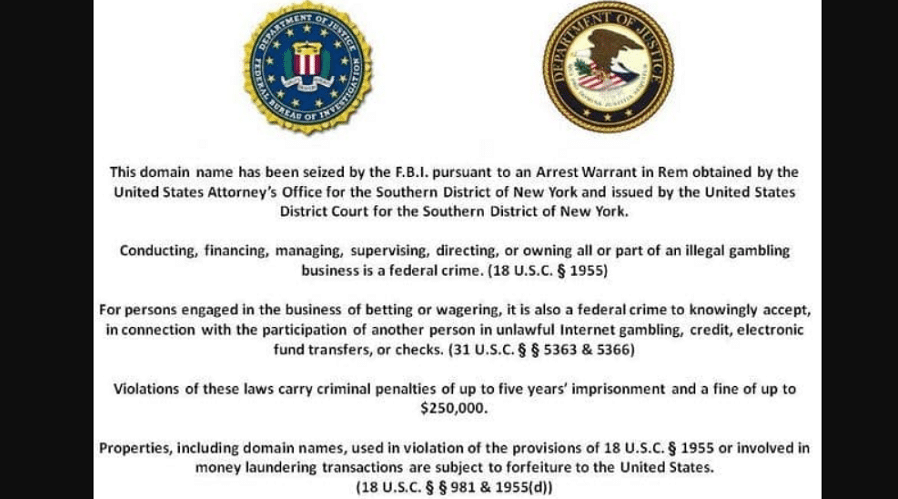
A website notice from US authorities on numerous popular online poker sites on Poker’s Black Friday. Image via Upswing Poker
On October 7th 2011, Charlie created Litecoin. The name comes from his vision of making “a lighter version of Bitcoin” which would be more convenient to use on a day-to-day basis. Oddly enough, Charlie considers Bitcoin to be the undisputed king of the cryptocurrency space and even advises people to invest in Bitcoin before anything else, including Litecoin. He also considers Litecoin to be the ‘digital silver’ which compliments Bitcoin, which is ‘digital gold’.

Charlie Lee, creator of Litecoin. Image via Bitcoinist
Although there were not many other cryptocurrencies around the time Litecoin was created, Charlie highlights that even back then many of them were intended to do nothing more than profit their creators. As such, Litecoin had no pre-mine – Charlie did not keep any Litecoin for himself but did buy and mine some like many others at the start. Charlie left Google in 2013 to work at Coinbase. He was one of the five employees there and was the director of engineering when he left in 2017.

Image via Twitter
That same year, Charlie sold his Litecoin, a move which angered many in the cryptocurrency community which were left wondering if the coin had any value if its creator had sold it off. This, in addition to comments he frequently made which upset Litecoin holders (such as calling Litecoin “boring”) led some to label him as the “most hated person in cryptocurrency” in 2017-2018.

Charlie Lee’s announcement that he sold/donated his Litecoin. Image via Reddit
Charlie has explained many times that his decision to sell his Litecoin was due to his incredible influence on its price. With over 800 thousand followers on Twitter, Charlie could see he was able move the Litecoin market with his tweets and decided that the best move for the long term success of the project would be to sell his Litecoin and focus entirely on development. Charlie has stated that he plans on continuing development on Litecoin well into the future and will never retire from the crypto space.
What is Litecoin?
Litecoin is one of the first cryptocurrencies ever made. It was built using Bitcoin’s core code and seeks to be a more convenient way of making payments involving smaller amounts of money. As such, Litecoin transactions are faster than Bitcoin’s and cost less to send.

A heatmap of places that accept Litecoin as payment. Image via Cryptwerk
Litecoin is accepted by tens of thousands of merchants and stores worldwide, most of which are in Europe and North America. There are also tens of thousands of cryptocurrency ATMs around the world which sell Litecoin, with over 13 000 in South Korea alone. As of September 2020, Litecoin is also available on the popular mobile banking app, Revolut.
Litecoin is open source and anyone can submit a Litecoin Improvement Proposal (LIP) on the Lightcoin Project Github. These proposals are discussed by the Litecoin community and then accepted or rejected by the Lightcoin Core development team which maintains and upgrades Litecoin.

Image via LinkedIn
The Lightcoin Core team is supported by the Litecoin Foundation, a non-profit organization based in Singapore focused on the adoption and awareness of Litecoin. It is funded entirely by donations and merch sales. Litecoin creator Charlie Lee is the Managing Director of the Litecoin Foundation as well as the lead developer of the Lightcoin Core team.
How does Litecoin work?
Litecoin works almost exactly like Bitcoin with a few minor differences. Like Bitcoin, Litecoin uses a proof of work consensus mechanism to validate transactions and generate new blocks on its blockchain. However, instead of using the SHA256 mining algorithm used in Bitcoin, Litecoin uses the Scrypt mining algorithm. It was designed this way so that anyone with a regular computer could mine Litecoin.

The Litecoin Antminer L3. Image via Alza
Unfortunately, specialized Scrypt ASIC miners were eventually developed, making it unprofitable to mine Litecoin with regular hardware. As such, most Litecoin mining today is done by Litecoin mining farms and Litecoin mining pools. Mining pools involving pooling computer power and sharing in the profits made from mining new Litecoin blocks. Fun fact: Dogecoin continues to exist because of Litecoin miners.
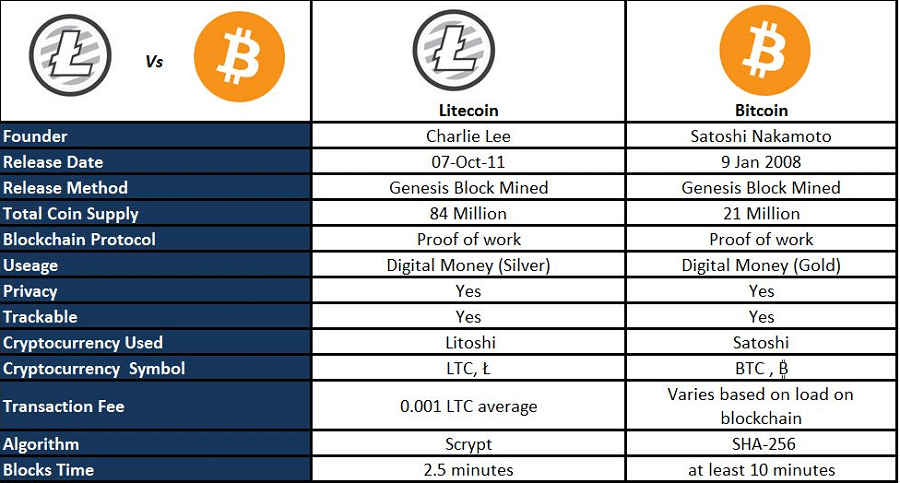
Litecoin vs. Bitcoin. Image via SeekingAlpha
A new Litecoin block is generated roughly every 2.5 minutes, 4x faster than Bitcoin’s 10-minute block generation time. Like Bitcoin, the block rewards were 50 Litecoin per block when it was created, and these block rewards are cut in half roughly every 4 years. Current block rewards are 12.5 Litecoin per block. The last Litecoin took place in August 2019, and the next halving will take place in August 2023.
In addition to miners, Litecoin features other network participants called nodes. Simply put, these are computers (AKA full nodes) or mobile devices (AKA light nodes or light clients) which further secure the network by storing and double-checking transaction data on the Litecoin network. Unlike miners, Litecoin nodes are not paid for their network participation (unless you count good karma as payment).
Litecoin SegWit

A technical explanation of SegWit. Image via CoinTelegraph
Litecoin implemented SegWit in 2017 and Bitcoin eventually followed suit. SegWit is a technology which prevents excess data from being written into new blocks. This frees up space for blocks to store more transaction data, increasing the number of transactions per second (TPS). SegWit doubled Bitcoin’s TPS from around 3 to 7 and Litecoin’s TPS from roughly 28 to 56.
Litecoin Lightning Network
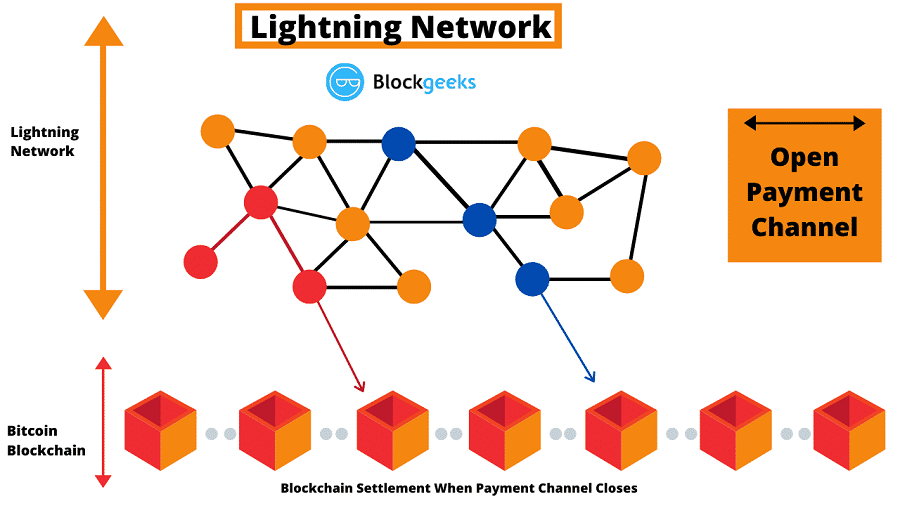
An illustration of the cryptocurrency Lightning Network. Image via Blockgeeks
Litecoin also supports the Lightning Network, an off-chain scaling solution which further increases TPS. It does this by opening a payment channel between two parties wherein multiple transactions can occur, with only the final balances being written to the blockchain by network nodes once the payment channel is closed. As with SegWit, Bitcoin implemented support for the Lightning Network shortly after.
Litecoin Atomic Swap

An example of an atomic swap between Litecoin and Bitcoin. Image via Medium
Litecoin executed some of the first ever atomic swaps with Decred, Vertcoin, and Bitcoin in late 2017. Atomic swaps allow you to exchange different types of cryptocurrency directly with other people without using a centralized service like an exchange. This is done by using automated contracts which release the desired cryptocurrency to a user’s wallet when certain conditions are met. Atomic swaps have since become common and are available on many cryptocurrency wallets.
Litecoin Mimblewimble
Litecoin is currently in the process of implementing Mimblewimble, a privacy technology used by the Grin privacy coin, which is also built from Bitcoin’s code. Mimblewimble is incredibly complicated but essentially involves making wallet addresses viewable only by the parties engaged in a transaction.

A technical illustration of Dandelion. Image via TariLabs
A technical illustration of Dandelion. Image via TariLabs
As a result, the only thing visible on the blockchain is the total amount transacted, which appears as a single transaction. Mimblewimble also uses a technology called Dandelion which hides any IP address data in a transaction.

The original Mimblewimble post.
Mimblewimble is named after the “Tongue-Tying Curse” from Harry Potter which prevents the cursed person from speaking coherently. Mimblewimble was proposed in 2018 by an anonymous developer using the pseudonym Tom Elvis Jedusor which is the French translation of Tom Marvolo Riddle, the famous Harry Potter anagram for “I am Lord Voldemort”.
Litecoin ICO
There was no initial coin offering for Litecoin. There was also no pre mine, though it is worth noting that there was technically a 3 block premine of 150 Litecoins by Charlie Lee to ensure everything was working properly. As such, the price of Litecoin at launch was technically 0$USD. Litecoin has a maximum supply of 84 million, which is 4x more than Bitcoin’s 21 million max supply.
LTC price analysis
Although Litecoin has been around since 2011, an ‘official’ Litecoin price history begins in early 2013 when CoinMarketCap went live. Litecoin spiked from a price of around 3$USD to 40$USD during the first crypto market bull run in late 2013. After dropping back down to the 3-4$USD range, it hit an all time high of nearly 400$USD during the 2017-2018 bull run, a 100x rally.
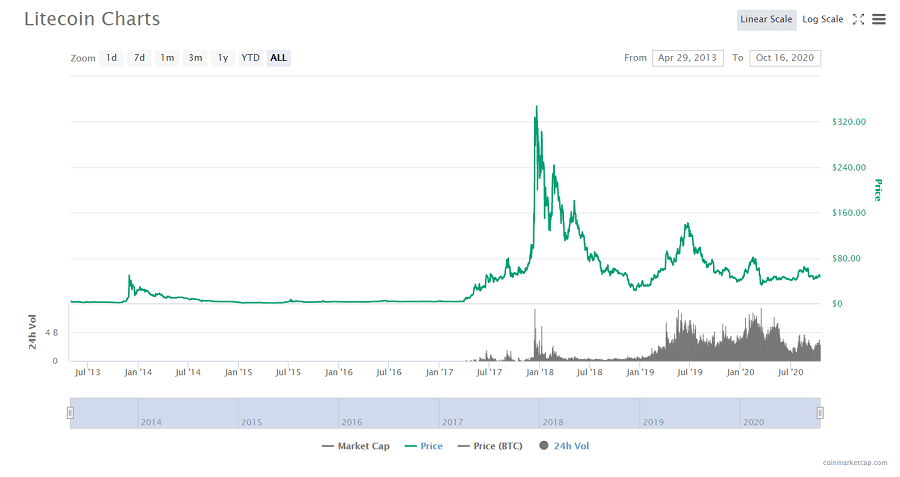
Litecoin's price history. Image via CoinMarketCap
Litecoin has been moving sideways since the March 2020 flash crash, hovering at a price between 40-70$USD and currently sitting around 45$USD. Support appears to be around the 42-43$USD range and it appears that the sideways trend will continue. Trading volume for Litecoin has been increasing gradually since September however, which may be indicative of another move to a 60-70$USD price (not financial advice!).
Where to get Litecoin
Litecoin is available on virtually every cryptocurrency exchange in existence. There are nearly 800 trading pairs for Litecoin, and its 24-hour trading volume is in the tens of millions of dollars on many reputable exchanges including Binance, Huobi, and Coinbase.

The top 10 Litecoin trading pairs. Image via CoinMarketCap
In short, you can get Litecoin just about anywhere you can find Bitcoin, and this is not limited to cryptocurrency exchanges either. Just remember that if you buy Litecoin with popular financial apps like Revolut or Uphold, you will likely pay more.
Litecoin cryptocurrency wallets
Since Litecoin has been around for almost as long as Bitcoin has, almost every single cryptocurrency wallet you can find supports Litecoin with few exceptions. Popular Litecoin hardware wallets include Trezor and Ledger devices.
Convenient Litecoin mobile and desktop wallets include the Exodus Wallet and Atomic Wallet. You can find an in-depth list of Litecoin wallets on the Litecoin website if none of the wallets mentioned here appeal to you. You can read all about our list of the best Litecoin wallets if you want to see more options on this front.
Litecoin Roadmap
There is no official roadmap for Litecoin. What is more is that despite being one of the oldest projects in the cryptocurrency space, there is surprisingly limited documentation out there about Litecoin. Much of the available information about Litecoin is also either fragmented, outdated, or unclear (which is a part of why we decided to write this article).
The closest document to a roadmap is found on The Lite School, an educational website by the Litecoin Foundation. It is not dated and provides no expected dates on when the noted improvements and additions will be implemented (if at all). Some of these have already been such as the Lightning Network, Atomic Swaps and Confidential Transactions (Mimblewimble – in progress).
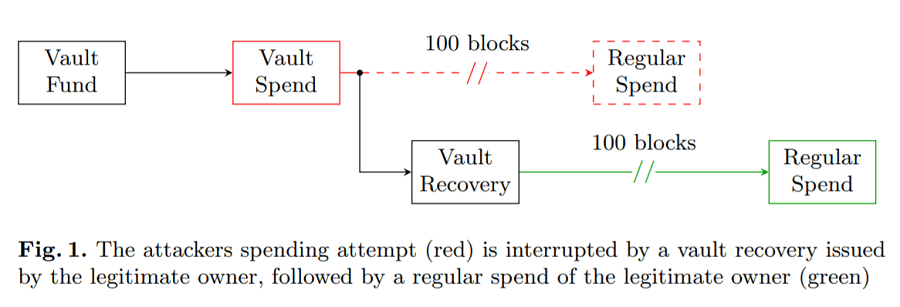
An illustration of a Litecoin/Bitcoin vault. Image via Bitcoin Covenants Whitepaper
Three additional features seem to be on Litecoin’s development backburner. The first feature is MAST, which will enable smart contracts on Litecoin. The second feature is Covenants, which will make it possible to create digital Litecoin vaults to help protect against theft. The third feature is called Colored Coins, which will allow you to assign special properties to individual Litecoins. This would make it possible to have a specific cluster of Litecoins double as the keys to your Tesla car.

Illustration of a side chain in cryptocurrency. Image via StackExchange
As noted previously, Litecoin is currently in the process of incorporating Mimblewimble. This will see the creation of a side-chain – a parallel Litecoin chain with Mimblewimble implemented, which can be interacted with from the main chain on an optional basis. In other words, you could choose to send your Litecoin to the Mimblewimble chain if you want your Litecoin transactions to be private.
The push for privacy on Litecoin was announced by creator Charlie Lee on Twitter at the beginning of 2019. He describes privacy as the “next battleground” in cryptocurrency and privacy has been his focus in almost every interview since. While there is no official date on when Mimblewimble will be available on Litecoin, a test net for the new feature was launched in early October this year.
Our opinion on Litecoin
Litecoin is a timeless classic. For those who have been in the crypto space for a few years, they will remember the days when holding Bitcoin, Ethereum, and Litecoin was an unspoken rule in the crypto community. While it may not be the cryptocurrency on everyone’s mind, Litecoin is one of the most important assets in the crypto space due to its role as a testbed for new Bitcoin upgrades and additions.

The unfinished website for the Lightcoin Core development team. Image via Lightcoin Core
That being said, it is surprising how disorganized an inaccessible existing information about Litecoin is. The project does not even have a whitepaper, which likely makes it hard for those who are new to cryptocurrency to give Litecoin any serious attention. Indeed, it is possible that Litecoin is primarily sustained by cryptocurrency veterans. With so much competition in the cryptocurrency space, having clear, concise, and up to date information is critical to the survival of a coin.

Image via Bloomberg
Additionally, Litecoin’s charge towards privacy may put it in the crosshairs of regulators who are becoming increasingly hostile towards privacy coins. Charlie Lee noted in an interview that it will be “interesting” to see if cryptocurrency exchanges begin delisting Litecoin when it adds support for Mimblewimble. Many exchanges have recently been delisting privacy coins due to pressure from regulators.

For context, the funds were going to be used to pay the defense lawyers of Ross Ulbricht, the creator of darknet marketplace Silk Road. Image via NewsBTC
The fact of the matter is that Charlie is right in calling privacy the next battleground for cryptocurrency. As blockchain firms such as Chainalysis and even cryptocurrency exchanges like Coinbase cozy up to government agencies around the world, concerns are justified, and countermeasures are warranted. The ability to be in control of one’s own data and money is critical in a digital world where everything is becoming increasingly watched and controlled.

A few popular privacy coins in cryptocurrency. Image via Blocksdecoded
As the next bull market approaches, the future of cryptocurrency stands at a crossroads: a complacent integration with legacy institutions, or a steadfast march towards a new, free, decentralized world. Litecoin has boldly chosen its side and might just be the first mover in a larger movement which has yet to materialize in the cryptocurrency space.
Featured Image via Shutterstock





